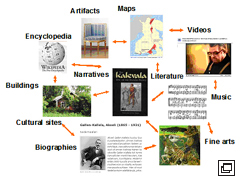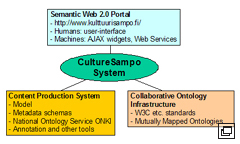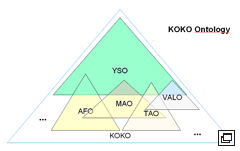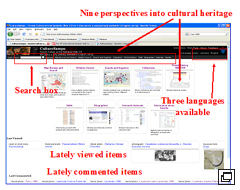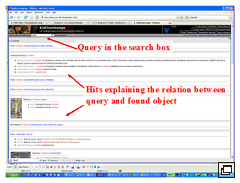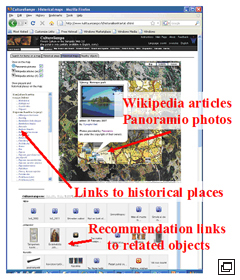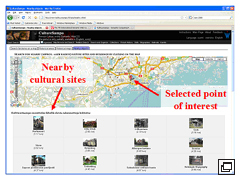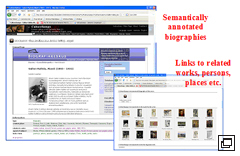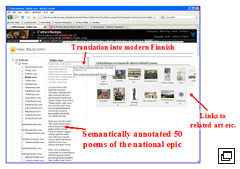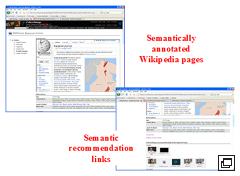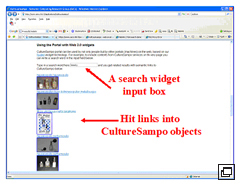MANUSCRIPT
Eero Hyvönen
CultureSampo: Finnish Cultural Heritage Collections on the Semantic Web 2.0
Abstract
This paper presents an overview of the SemanticWeb 2.0 application CultureSampo, an ambitious system for creating a collective semantic memory of the cultural heritage of a nation on the Semantic Web 2.0, combining ideas underlying the Semantic Web and the Web 2.0. The system addresses the semantic web challenge of aggregating highly heterogeneous, cross-domain cultural heritage content into a semantically rich intelligent system for human and machine users. At the same time, CultureSampo is an approach to solve the social and practical Web 2.0 challenge of organizing the underlying collaborative ontology development and content creation work of memory organizations and citizens.
I. Components of a National Semantic Memory
The research question of this paper is:
How to publish cultural heritage collections on the web involving virtually all kind of cross-domain contents of memory organizations and citizens?
The targeted system should have the following properties:
- From the publishers' viewpoint, it is possible to publish content easily by providing semantic metadata locally. Expensive manual work on the global portal side is minimized.
- The contents are automatically linked with other publishers' contents and get semantically enriched from each other.
- Researchers and citizens can contribute to the contents of the system with their own contents and knowledge.
- From the end users' viewpoint, contents can be accessed easily from different user-centric thematic perspectives and contexts.
- Intelligent search and browsing services of the application can find answers to questions in addition to data records.
- The aggregated contents and services of the system can be reused in external web applications easily as mash-ups.
- Multilinguality is supported; language barriers can be overcome.
Fulfilling these desires is challenging due to two major reasons:
- Semantic challenges. Cultural heritage content is semantically heterogeneous and available in various forms (documents, images, audio tracks, videos, collection items, learning objects etc.), concern various topics (art, history, handicraft etc.), is written in different languages, and is targeted to both nonprofessionals and experts. Furthermore, the content is mutually interlinked, as depicted in figure 1.1. For example, the (meta)data may contain a person's narrative biography, works of art she created, places of interest where she lived in, Wikipedia articles or novels about or by the person, social connections to other persons, and events in the history that the person was related to.
- Organizational challenges. Various mutually independent museums, archives, libraries, media organizations, associations, and individual citizens create cultural heritage content. This kind of distributed content creation model has lead to a situation, where even simple metadata about a single homogenous content type, such as museum artifacts, can be highly incompatible in different institutions [19]
This paper presents an overview of CultureSampo [1, 22] addressing these challenges on a national Finnish level, based on semantic web technologies [34] and Web 2.0. The system has been developed since 2004, starting from the portal "MuseumFinland-Finnish Museums on the Semantic Web" [19], as a part the FinnONTO project for building a national level semantic web content infrastructure with practical applications [2, 3]. The first public prototype of the system, based on contents from 22 Finnish memory organizations, various international sources, and citizens, was published in September 2008 and can be used in three languages on the web [22].
CultureSampo consists of three components (cf. figure 1.2):
- Collaborative ontology infrastructure. The basis of CultureSampo is the national FinnONTO infrastructure [2, 3] that includes a collaboratively created system of cross-domain ontologies and related ontology services for utilizing them cost-efficiently [4]. The ontologies and the services were released in several languages on the public web as the National Ontology Service ONKI [26] on September 12, 2008.
- Content production system. Our model consists of a set of metadata models and a content creation process for producing and harvesting content from museums, libraries, archives and other organizations, as well as from individual citizens and Web 2.0 sources, such as Wikipedia and Panoramio [27].
- Semantic Web 2.0 portal. The portal itself is unique in its use of versatile cross-domain semantic models, new semantic searching and browsing methods, and semantic visualizations for the end-users.
In the following, these three components are overviewed with an emphasis on functionalities of the portal. After this, contributions of the work to related research are summarized.
II. A TOUR OF MITH
An integral part of CultureSampo are the ontologies of the FinnONTO infrastructure. They complement the generic, logic based W3C semantic web recommendations, such as RDF, OWL, and SPARQL, with domain specific ontologies in different domains. Most of the FinnONTO ontologies were developed by transforming nationally used thesauri into light weight ontologies. The process was not purely mechanical, like e.g. in [5], but also manual processing was required in order to refine the semantic thesaurus relations into full blown subsumption hierarchies. In the FinnONTO model, the ontologies in different domains are developed in a distributed fashion by collaborating expert groups of different fields, and are mapped together to form a large national ontology called KOKO encompassing all domains. At the moment, KOKO includes an upper ontology YSO (20 600 concepts), a cultural heritage ontology MAO (6800 concepts), an agriforestry ontology AFO (5500 concepts), an applied art ontology TAO (2600 concepts), and a photography ontology VALO (1900 concepts). Figure 2.1 illustrates the KOKO system of mutually mapped ontologies where YSO constitutes the upper ontology.
The ontologies are provided to end-users not only in RDF/OWL form, as usual, but as ready to use semantic web widgets [6] using Web 2.0 AJAX APIs, as well as through conventional Web Services [4]. The KOKO ontology as a single whole is used as the ontological basis of CultureSampo. In addition to KOKO, CultureSampo also utilizes a geographical registry of 800,000 places in Finland, a spatiotemporal ontology of historical Finnish municipalities 1865-2007 [7], an ontology of persons and organizations, and ontologized international vocabularies such as the Iconclass [28], the Art and Architecture Thesaurus (AAT) [29], and the Union List of Artists Names (ULAN) [29].
III. Content Production System
CultureSampo contains cultural objects of nearly 30 different content types including artifacts, paintings, drawings, sculptures, pieces of abstract art, novels, comics, web pages, three types of folklore, five types of folk music, photos, aerial photos, persons, organizations, biographies, historical events, skills, videos, buildings, and archeological sites. These content types are represented using 18 different metadata schemas. The aggregated knowledge base contains 52,000 cultural objects and 235,000 other resources, such as ontological class concepts and place instances. The cultural objects are described by 784,000 property triples.
The content is enriched using reasoning, resulting in some 10 million property triples. The enriched knowledge base is used for intelligent information retrieval and for creating semantic recommendation links between objects. The content is represented using RDF and OWL, and SPARQL is used for recommendations. The system also utilizes external web resources through web services: all Wikipedia articles (in English and Finnish) that have coordinate information, as well as photographs of the Panoramio service can be found on CultureSampo's map views.
These information sources have diverse ownerships. The contents come from 22 Finnish museums, archives, and libraries, most of which produce their contents independently from each other using heterogeneous cataloging systems and practices, e.g. different vocabularies. Wikipedia and Panoramio content is created internationally by the public. CultureSampo also has a commenting facility by which individuals can contribute new knowledge to individual content items, e.g. identify persons in an old photograph of a museum collection. In these ways, citizens are able to contribute to the national semantic memory. Furthermore, interactive content production based on the SAHA editor [8] has been used internally in the system by the participating organizations.
From a semantic modeling viewpoint, one research focus of our work has been event- and process-based annotations used in artificial intelligence and knowledge representation [9]. In our case, events have been used for modeling cultural processes and narrative stories [1, 10] and for metadata schema integration [11, 12]. The KOKO ontology was designed to support this by clearly separating events and processes from other concepts as in Dolce [13]. In some metadata schemas of CultureSampo it is possible to annotate content using processes in terms of events, subevents and their sequences. The model in use in the prototype is a simplified version of our earlier schema [10]. The portal then automatically generates an interactive representation of the process as a kind of a temporal table of contents. This system is used in the prototype for creating skill descriptions, cultural process descriptions, and documentation of processes in videos:
- Semantic skill models. An example of a skill model is the model "Production of Ceramics" produced by experts at the University of Applied Arts in Helsinki. It illustrates and explains the composition of different work phases when manufacturing ceramics. At each phase, semantic recommendations to other relevant CultureSampo contents can be created automatically. For example, links to products in collections that were manufactured using the same techniques, are automatically obtained.
- Semantic models of cultural processes. There is a similar kind of chronological model "A Year on a Farm" of the seasonal farming events and processes taking place at a typical farm in Finland. Again, tools and other materials from CultureSampo are linked automatically with related events. This model was created by a farmer employed at the Finnish Museum of Agriculture. The exhibition of this museum is actually organized using the same idea of presenting farming events taking place during different yearly seasons.
- Semantic documentation on videos. The annotation model can be applied also to documenting instances of actual skill events or processes documented on a video. The case example available on the portal describes how the shoemaker Onni Wirlander manufactured a pair of traditional leather boots. The video was produced, and the annotation created, by the Espoo City Museum using the SAHA editor connected to the ONKI ontology services. The semantic model describes what happens at different (sub)sequences on the video. Semantic search can find not only the video as a black box, as in systems such as YouTube, but also points of interest inside the video. The video can be viewed directly starting from different points of interest. This is important with longer videos.
The examples above demonstrate our new ideas of representing and storing immaterial, procedural cultural heritage in the memory system, here descriptions of handicraft skills and cultural processes. Typical cultural heritage portals contain metadata only about static objects such as artifacts.
Content creation in CultureSampo, both ontologies and the metadata, is based on distributing the work to organizations and citizens in a Web 2.0 fashion. In this strategy, extra costs can be minimized by reorganizing the work done already in the organizations and in public. The work is supported by a number of generic FinnONTO tools, such as the metadata editor SAHA, information extraction tool POKA [23], and the semantic content validator VERA [24].
IV. SEMANTIC WEB 2.0 PORTAL
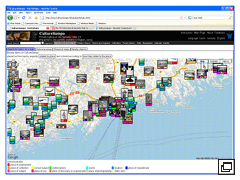
Figure 4.3 Collection objects on the map based on 12 different spatial relations.
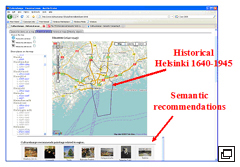
Figure 4.4 Historical areas tab.
The most important part of CultureSampo for the end-user is the semantic web 2.0 portal. Figure 4.1 depict the front page of this application. The system is multilingual: Finnish, Swedish, or English can be selected by the links in the upper right corner. However, because nearly all contents are in Finnish and translations of some parts of the Finnish KOKO ontologies are not available, the system is not equally powerful in other languages. On the bottom of the page, lately viewed objects from the knowledge base are shown, as well as objects that have been commented by end-users lately.
In the upper left corner, there is a Google-like search box for typing in a search query. Then semantic autocompletion [14] is used, semantic query expansion and reasoning is employed during the search, and the underlying ontologies are used to organize the results into meaningful categories. For example, in figure 4.2 the user is typing into the search box a hero's name "Kuller..." mentioned in the Kalevala epic, and the results are categorized by the roles connecting the hero and the matched objects, e.g., paintings depicting him, runes telling about him etc.
A major novelty of the portal is to provide the end-user with access to the cultural RDF knowledge base through nine "thematic perspectives. They are available at the main entry page and as choices in the menu bar (cf. figure 4.1 in the middle). These perspectives are overviewed below in order to illustrate the underlying ideas and functionalities available. New perspectives can be added into the system fairly easily, because the underlying architecture is based on a set of general service components, such as the semantic recommending system.
Perspective 1: Maps Search and Browse Views
There are four map views [14] available using Google Maps. Each view has its own tab:
- The tab "Search for Items on the Map" shown in figure 4.3 displays any collection object with coordinate information on Google Maps, and tells the semantic relations of objects to the places. There are 12 different spatial relations in use, such as "place of acquirement", "place of subject", and "place of manufacture".
-
The tab "Historical Areas" is used for finding old Finnish counties with their digitized limits on the maps, based on the spatiotemporal Finnish place ontology SAPO [23]. In figure 4.4, a link directory to old places is shown on the left, and the user has selected the historical Helsinki. Semantic recommendation links to related collection items are automatically shown on the bottom of the page with short explanations about their relation to the place.
- The tab "Historical Maps" [14] is used for viewing historical maps layered semi-transparently over modern Google Maps. Wikipedia articles in Finnish or English with coordinate information, and photos from the Panoramio service can be seen on the maps and can be opened by clicking on them. For example, in figure 4.5 old Finnish Karelian maps are viewed semi-transparently on top of modern Russian Google Maps [23] (this area is part of Russia today). The user has located the historical Finnish park "Monrepos", and found a modern Panoramio photograph there, taken by a contemporary Russian citizen. On the left, there is also the index of old Finnish places on the maps as direct selection links. Semantic recommendations to collection items related to historical places on the maps are displayed below. In this case, for example, links to pieces of folk music and poems collected from the region can be seen, as well as related paintings, artifacts, and old aerial photographs.
- The fourth tab "Nearby objects" is used for finding nearby objects of interest: the user clicks a point and the system finds nearby cultural sites of interest (cf. figure 4.6).
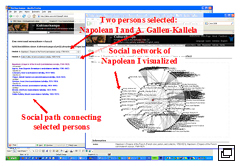
Figure 4.7 Answering the question "How is Napolean I, the French emperor, related to Akseli Gallen.-Kallela, the Finnish artist?" by relational search.
Perspective 2: Relational Search
The relational search perspective is a demonstration of relational search [31] also called association identification or knowledge discovery [32]. Here the idea is not to search for objects but associative relation chains between objects. We used the ULAN registry of 120,000 artists and organizations with 390,000 names. Here the user can type in two names, using semantic autocompletion, and CultureSampo tells how the persons or organizations are related to each other by the social network based on some 50 different social roles (e.g., parent-of, teacher-of, patron-of etc.). The underlying social RDF/OWL network can also be browsed by a graphical network browser. For example, in figure 4.7 the user typed in Napolean I (the French emperor) and Akseli Gallen-Kallela (a Finnish artist), and CultureSampo found a social path of 7 steps between the persons. The browsable social network of Napolean I is depicted on the right hand side window.
Perspective 3: Search and Organize
In this view, a new kind of generalized version of semantic faceted or view-based search [19] has been developed, called domain centric search. In this approach, domain ontologies and the myriad of different properties and roles related to the metadata schemas employed, can be used for very flexible queries and for the analysis of portal contents. The search results can be classified along different domain ontologies (e.g. object types, materials, manufacturers, etc.), projected along a timeline [36], or shown on maps. For example, it is possible to find out what themes were most popular in the Finnish novels publishes in 2007, what colors were used in different textile types during different time periods, or in what places certain kinds of artifacts have been manufactured.
Perspective 4: Collections
Here the contents can be accessed based on an organizational view. Each participating organization has an automatically generated home page in the system with links to its collections and the actual collection items.
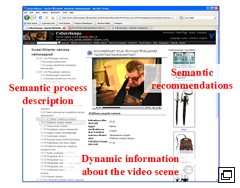
Figure 4.7 Answering the question "How is Napolean I, the French emperor, related to Akseli Gallen.-Kallela, the Finnish artist?" by relational search.
Perspective 5: Finnish History
This view is based on an ontology representing events in the Finnish history [33]. These events are of interest on their own, but are also used to create semantic recommendations to other contents, e.g. to biographies of persons participating in the events. The history ontology in the prototype system contains 220 events on a timeline in 1860-1919. The content originates from the Agricola portal maintained by history researchers [25].
Perspective 6: Skills and Cultural Narratives
Figure 4.8 depicts the idea of documenting traditional skills semantically on videos, and providing the documentation through a semantic video viewer. The use case here is the shoemaker Wirlander producing a pair of leather boots. This process has been described semantically as a sequence of hierarchical events that take place in the video in different parts. The corresponding "table of contents" is automatically generated for the end-user on the left. The user can then view any part of the video by selecting items from the list.
In the screenshot, the user is viewing the part "sharpening of the knife". At the same time, the system recommends items of interest in the collections, in this case different knives belonging to the collections of the museums. Each part of the video that forms a meaningful entity is a search object of its own, and can be found through the general search engine of the system.
Perspective 7: Biographies
In this view, biographies of the National Biography are used to access CultureSampo contents. When reading the biographies, related contents are shown as recommendations based on the concepts extracted from the text using the information extraction tool POKA [23].
Perspective 8: Semantic Kalevala
This view contains a semantically annotated version of the national epic of Finland, Kalevala, that is related in many ways to Finnish art and culture. The epic also has interesting links to old Finnish folklore, on which it is actually based, and to folk music lyrics. Thousands of runes and pieces of folk music are available in the portal. When reading Kalevala, annotations related to its subsequences can be viewed to help reading, and semantic recommendations to related materials in CultureSampo are automatically produced [17].
Perspective 9: Karelia
This last thematic perspective contains Wikipedia articles about the Karelia area in Finland that has been influential to the Finnish culture. For example, lots of folklore has been collected into national archives from this area, and the Kalevala epic is strongly associated there. Like in the biographies view, the POKA system is used for extracting concepts from the texts (here web pages). Based of the extracted concepts, semantic recommendations to related contents are created for additional information (cf. figure 4.11).
In addition to human end-users, the system can be used by machines via AJAX interface and widgets. The application use case here is that collaboratively aggregated and semantically enriched national knowledge base can be used not only by the CultureSampo portal but also by other portals and systems on the web. To facilitate this we introduce the cost-effective idea of utilizing ready to use Web 2.0 mash-up services in the same spirit as Google Ads or Maps are used on external web pages and applications. In this way, museums, libraries, tourism portals, news papers, individual citizens, and other users can include CultureSampo materials, such as semantic search results and recommendation links, on their web pages using mash-ups. This clearly benefits everybody: the materials of the CultureSampo collaborative network get more visibility and the external users can enrich their own materials for "free": only 1-2 lines of Javascript code is needed.
An example mash-up is depicted in figure 4.12. Here the use types in a search word in the input field. After each character input, the CultureSampo service is queried and the matching results are displayed below the search field. In this case, the user is typing "beauty" in English, and bathroom equipments and some paintings related to the concept are returned. The actual contents are available only in Finnish. However, search can be performed successfully because parts of the underlying ontologies are available in English and Finnish.
V. DISCUSSION
The vision and design of CultureSampo goes beyond current semantic web portals for cultural heritage [18], such as [19, 20, 21]. The contributions of the work underlying the CultureSampo system have many facets and have been made during several years. The contribution of this paper is to give an overview of the whole system, its philosophy, and the new thematic perspective based end user interface, with pointers to papers and web sites explaining the approaches and software developed in more detail.
To summarize our work, CultureSampo contributes to research and development of semantic portals for cultural heritage especially in the following ways:
- Cross-domain content, ontologies, and metadata. The system is highly cross-domain with dozens of content types and metadata schemas. Usually only one schema such as Dublin Core or VRA Core [35] is used in cultural portals.
- Event-based narrative semantic models. CultureSampo makes use of sophisticated semantic annotation models including events and processes.
- Semantic search and recommending. The system uses new kinds of semantic search and recommendation techniques.
- Semantic visualizations. The system has an exceptionally versatile selection of semantic visualizations available, such as different map views, timelines, graphs, process visualization, and semantic video viewing.
- Collaborative ontology development. The system is based on a large nationwide collaboratively maintained infrastructure of ontologies and ontology services.
- Collaborative metadata creation. The system includes a model of and tools for collaborative semantic content creation.
- Machine semantics and services. The services can be made available for machines.
- Large collaboration network. The system has been developed on a national level with contents from over 20 memory organizations, and includes content from many international sources.
- Multilinguality. Although the contents are in Finnish, the system can be used in two other languages.
Two user evaluation studies concerning semantic recommendations of an earlier version of CultureSampo have been performed with some promising results [11]. However, end user evaluation of the interfaces of the new prototype with its various features has not yet been done.
The portal is scalable in terms of its Web 2.0 content creation model and different types of content. An explicit concern in implementing the portal has been the computational efficiency in terms of speed and memory consumption, since a national level cultural heritage portal, if successful, will have lots of content inside and a large number of simultaneous users. For this goal, our earlier memory- and Prolog-based search engine used in MuseumFinland was replaced by conventional search engine technology, Apache Lucene, that was configured to do semantic search using semantic indexing. The CultureSampo search engine has been tested with a knowledge base of 20 million objects resulting in response times of less than 2 seconds on ordinary PC hardware.
ACKNOWLEDGEMENTS
Several researchers, including, Airi Hortling, Jouni Hyvonen, Ellen Karhulampi, Suvi Kettula, Helena Makimattila, and Jari Vaatainen, have contributed to developing CultureSampo contents and the related infrastructural components. This work is a part of the national FinnONTO research project 2003-2007, 2008-2010, funded mainly by Tekes and a consortium of 38 companies and public organizations. The work is also partly funded by the EU FP7 SmartMuseum project 2008-2010, and the Finnish Cultural Foundation (2008-2010).
REFERENCES
- [1]
- Hyvonen, E., Ruotsalo, T., Haggstrom, T., Salminen, M., Junnila, M., Virkkila, M., Haaramo, M., Kauppinen, T., Makela, E., Viljanen, K.: CultureSampo-Finnish culture on the semantic web. The vision and first results. In: Klaus Robering (Ed.), Information Technology for the Virtual Museum. LIT Verlag. (2008)
- [2]
- Hyvonen, E., Viljanen, K., Tuominen, J., Seppala, K.: Building a national semantic web ontology and ontology service infrastructure-the FinnONTO approach. In: Proceedings of the ESWC 2008, Tenerife, Spain, Springer- Verlag (2008)
- [3]
- Hyvonen, E.: Semantic interoperability of content and services. Developing and Using a National Cross-domain Semantic Web Infrastructure. In: P. Sheu, H. Yu, A. Joshi, C.V. Ramamoorthy, and L.A. Zadeh (eds.): Semantic Computing, IEEE Press / Wiley, New York (2009, forth-coming)
- [4]
- Viljanen, K., Tuominen, J., Kansala, T., Hyvonen, E.: Distributed semantic content creation and publication for cultural heritage legacy systems. In: Proceedings of the 2008 IEEE International Conference on Distibuted Human- Machine Systems, Athens, Greece, IEEE Press (2008)
- [5]
- van Assem, M., Malaise, V., Miles, A., Schreiber, G.: A method to convert thesauri to SKOS. In: Proceedings of the Third European Semantic Web Conference (ESWC'06), Springer-Verlag (2006)
- [6]
- Makela, E., Viljanen, K., Alm, O., Tuominen, J., Valkeapaa, O., Kauppinen, T., Kurki, J., Sinkkila, R., Kansala, T., Lindroos, R., Suominen, O., Ruotsalo, T., Hyvonen, E.: Enabling the Semantic Web with Ready-to-Use Web Widgets. In Nixon, L., Cuel, R., Bergamini, C., eds.: First Industrial Results of Semantic Technologies, proceedings, co-located with ISWC 2007 + ASWC 2007, Busan, Korea. (2007) CEUR Workshop Proceedings, Vol 293.
- [7]
- Kauppinen, T., Vaatanen, J., Hyvonen, E.: Creating and using geospatial ontology time series in a semantic cultural heritage portal. In: Proceedings of the ESWC 2008, Tenerife, Spain, Springer-Verlag (2008)
- [8]
- Valkeapaa, O., Alm, O., Hyvonen, E.: Efficient content creation on the semantic web using metadata schemas with domain ontology services. In: Proceedings of ESWC 2007, Innsbruck, Austria, Springer-Verlag (2007)
- [9]
- Sowa, J.: Knowledge Representation. Logical, Philosophical, and Computational Foundations. Brooks/Cole (2000)
- [10]
- Junnila, M., Hyvonen, E., Salminen, M.: Describing and linking cultural semantic content by using situations and actions. In: Klaus Robering (Ed.), Information Technology for the Virtual Museum. LIT Verlag. (2008)
- [11]
- Ruotsalo, T., Hyvonen, E.: A method for determining ontology-based semantic relevance. In: Proceedings of the International Conference on Database and Expert Systems Applications DEXA 2007, Regensburg, Germany, Springer (2007)
- [12]
- Ruotsalo, T., Hyvonen, E.: An event-based approach for semantic metadata interoperability. In: Proceedings of the ISWC 2007 + ASWC 2007, Busan, Korea, Springer-Verlag (2007)
- [13]
- Gangemi, A., Guarino, N., Masolo, C., Oltramari, A., Schneider, L.: Sweetening ontologies with DOLCE. In: Proc. of the 13th International Conference on Knowledge Engineering and Knowledge Management. Ontologies and the Semantic Web, Springer-Verlag (2002)
- [14]
- Hyvonen, E., Makela, E.: Semantic autocompletion. In: Proceedings of the First Asia SemanticWeb Conference (ASWC 2006), Beijing, Springer-Verlag (2006)
- [15]
- Kurki, J., Hyvonen E.: Relational semantic search: Searching social paths on the semantic web. In: Poster Proceedings of the ISWC + ASWC 2007, Busan, Korea. (2007)
- [16]
- Makela, E., Suominen, O., Hyvonen, E.: Automatic exhibition generation based on semantic cultural content. In: Proc. of the Cultural Heritage on the Semantic Web Workshop at ISWC + ASWC 2007. (2007)
- [17]
- Hyvonen, E., Takala, J., Alm, O., Ruotsalo, T., Makela, E.: Semantic Kalevala-accessing cultural contents through semantically annotated stories. In: Proceedings of the Cultural Heritage on the Semantic Web Workshop at the 6th International SemanticWeb Conference (ISWC 2007), Busan, Korea. (2007)
- [18]
- Hyvonen, E.: Semantic portals for cultural heritage. In: Handbook of Ontologies, 2. edition, Springer-Verlag (March 2009).
- [19]
- Hyvonen, E., Makela, E., Salminen, M., Valo, A., Viljanen, K., Saarela, S., Junnila, M., Kettula, S.: MuseumFinland-Finnish museums on the semantic web. Journal of Web Semantics 3(2) (2005) 224-241
- [20]
- Schreiber, G., Amin, A., van Assem, M., de Boer, V., Hardman, L., Hildebrand, M., Hollink, L., Huang, Z., van Kersen, J., de Niet, M., Omelayenko, B., van Ossenbruggen, J., Siebes, R., Taekema, J., Wielemaker, J., Wielinga, B.J.: MultimediaN e-culture demonstrator. In: The Semantic Web - Proceedings of the 5th International Semantic Web Conference 2006. (2006) 951-958
- [21]
- Wang, Y., Stash, N., Aroyo, L., Gorgels, P., Rutledge, L., Schreiber, G.: Recommendations based on semantically-enriched museum collection. Journal of Web Semantics (2008)
- [22]
- CultureSampo portal: http://www.kulttuurisampo.fi/
- [23]
-
Home page of the POKA information extraction tool:
http://www.seco.tkk.fi/tools/poka/
- [24]
-
Home page of the semantic validator tool VERA:
http://www.seco.tkk.fi/services/vera/
- [25]
-
Agricola timeline and material about events in Finnish history:
http://agricola.utu.fi/
- [26]
- National Ontology Library Service ONKI: http://www.yso.fi/
- [27]
- Panoramio Photo Service: http://www.panoramio.com/
- [28]
- Iconclass home page: http://www.iconclass.nl/
- [29]
-
Art and Arcitechture Vocabulary AAT:
http://www.getty.edu/research/conducting research/vocabularies/aat/
- [30]
-
Union List of Artists Names (ULAN):
http://www.getty.edu/research/conducting research/vocabularies/ulan/
- [31]
- Kurki, J., Hyvonen: Relational semantic search: Searching social paths on the semantic web. In: Poster Proceedings of the ISWC + ASWC 2007, Busan, Korea. (2007)
- [32]
- Sheth, A., Aleman-Meza, B., Arpinar, I.B., Bertram, C., Warke, Y., Ramakrishnan, C., Halaschek, C., Anyanwu, K., Avant, D., Arpinar, F.S., Kochut, K.: Semantic association identification and knowledge discovery for national security applications. Journal of Database Management on Database Technology 16(1) (Jan-March 2005) 33-53
- [33]
- Hyvonen, E., Alm, O., Kuittinen, H.: Using an ontology of historical events in semantic portals for cultural heritage. In: Proceedings of the Cultural Heritage on the Semantic Web Workshop at the 6th International Semantic Web Conference (ISWC 2007). (November 12 2007)
- [34]
- W3C Semantic Web Activity: http://www.w3.org/2001/sw/
- [35]
- VRA Core home page: http://www.vraweb.org/projects/vracore4 /
- [36]
- The Simile timeline system is used: http://simile.mit.edu/timeline/
